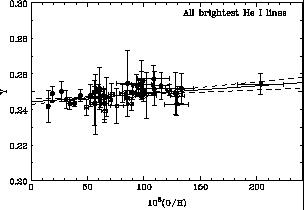


8.1 The Primordial Helium Abundance
According to conventional wisdom, helium is mainly produced in the first few minutes of our observed Universe and subsequent stellar nucleosynthesis has added at most 10 to 20% to its primordial value. An accurate measurement of the primordial Helium is critical for our understanding of the origin of the Universe because, under the assumption of the standard hot Big Bang model of nucleosynthesis, it will eventually provide a fundamental parameter in cosmology, that is, the nucleon density in the early Universe. Up to now, the most accurate method of measuring helium abundance consists of observing diffuse gas which has been ionised by the ultraviolet photons from hot stars in star forming dwarf galaxies, in particular BCGs. The goal being to measure Y, the helium mass fraction present in ionised gas of low heavy element abundance. Early studies have pioneered a method by which one can extrapolate the He/H versus O/H relation to the primordial abundance, Yp as the oxygen abundance tends to zero (Peimbert & Torres-Peimbert 1974; Lequeux et al. 1979). The extrapolation is rendered easier by choosing extreme metal-poor galaxies. Extensive searches are still underway to select blue low mass galaxies with even lower oxygen abundance and of highest excitation. This last point is crucial, since a good oxygen and helium abundance determination is only possible if the temperature of the gas can be obtained from the very few critical forbidden line ratios which can be properly measured (Kunth and Sargent 1983). Because useful constraints can only be achieved if the He abundance is measured to better than 5% accuracy this exercise needs care at each step that from the observations leads to the final derivation. Problems connected with fluorescent and collisional excitation affecting the helium lines must be addressed as well as the effect induced by electron temperature fluctuations. Another irritating question is the amount of neutral helium to correct for, because it remains undetected (Masegosa et al. 1994). The stellar population, due to the most recent burst of star formation, produces underlying absorption in the H and He nebular lines (Izotov and Thuan 1998a). To circumvent this difficulty, high resolution spectroscopic data are needed. Despite improved observations, the scatter in the Y vs Z diagram has remained large (see e.g. Kunth 1996). Is this due to systematic errors or an intrinsic cosmic dispersion? It has been argued that galaxies with high Y might be affected by localised pollution from Wolf-Rayet (WR) stars (Pagel et al. 1986, 1992), and hence that galaxies showing (WR) features should be excluded from the analysis. However, this has been disputed by Esteban and Peimbert (1995) and Kobulnicky and Skillman (1996) who find no evidence for localised pollution in WR galaxies.
The problem of the recombination coefficients for helium has been a subject of controversy after Smits (1991) published new values that differed from those of Brocklehurst (1972), but these calculations were discovered later on to be in error by Smits himself (1996). A new grid of emissivities improving the predictions for He emission lines are now available (Benjamin et al. 1999). Problems inherent to the observations and reduction processes have also been considered and have led to at least two distinct approaches. One method (Skillman et al. 1994) involves repeated observations with different systems (telescopes, standard stars, reduction procedures, etc.) while Thuan and Izotov (1998a) have favoured an approach by which the same procedure (telescope, etc.) is used to ensure more homogeneity of the data. Reviews of some problems in connection with deriving the primordial He abundance can be found in Terlevich et al. (1996) and Kunth (1996).
The last estimate of the primordial helium abundance (Izotov and Thuan 1998a) using a ``self-consistent'' treatment, gives Yp = 0.244 ± 0.002 (see Fig. 11), a value slightly higher than that of Pagel et al. (1992), i.e. more in line with the predictions of the Standard Big Bang nucleosynthesis. Perhaps equally important, is a considerable scatter in the helium values at a given metallicity: an indication of possible differences in the chemical evolution history of these dwarf galaxies. This scatter remains, although observational errors have been considerably reduced over the last decade with the advent of linear detectors. The new Izotov and Thuan (1998a) data are available in a way that offers the possibility to check various pending observational problems (such as a grating ``second order'' contamination that is possibly present beyond 7200 Å and may affect redshifted objects in the 7065Å HeI line) and perform independent analysis. Their work however still leaves room for further investigation in particular to check the importance of underlying stellar absorption that may artificially weaken some HeI lines. It is for this unfortunate reason that region NW in the most deficient metal-poor IZw18 is difficult to use and has been alternatively rejected and reintroduced by Izotov and Thuan (1998a, b) in the final derivation. The advent of 2D spectroscopy will also help to better take into account stratification effects in the nebula and localise possible contaminations due to WR stars and supernovae.

|
Figure 11. Example of recent derivation of the primordial He abundance through regression analysis. The meaning of filled vs. open symbols is described in Izotov and Thuan (1998). (Courtesy T.X. Thuan.) |